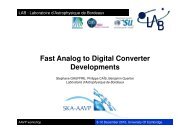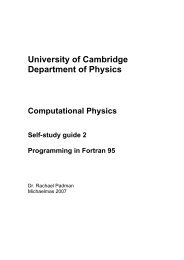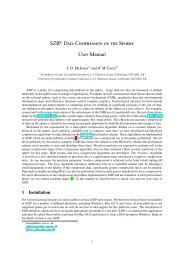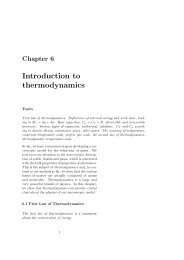Bayesian Methods for Astrophysics and Particle Physics
Bayesian Methods for Astrophysics and Particle Physics
Bayesian Methods for Astrophysics and Particle Physics
Create successful ePaper yourself
Turn your PDF publications into a flip-book with our unique Google optimized e-Paper software.
LIST OF FIGURES<br />
3.6 1–D Marginalized posteriors <strong>for</strong> flat-ΛCDM Cosmology with Cos-<br />
moMC <strong>and</strong> 48,000 likelihood evaluations (solid black), CosmoMC<br />
<strong>and</strong> 3,200 likelihood evaluations (dotted pink) <strong>and</strong> MultiNest<br />
with 3,100 likelihood evaluations (dashed blue). . . . . . . . . . . 89<br />
4.1 Samples drawn from the Press–Schechter mass function. The con-<br />
tour enclose 68%, 95% <strong>and</strong> 99% of the probability. . . . . . . . . . 100<br />
4.2 Left panel shows the true convergence map of the simulated clusters<br />
discussed in Section 4.4.1. Middle panel shows the denoised conver-<br />
gence map made with the LenEnt2 algorithm. Right panel shows<br />
the inferred convergence map made with the MultiNest algorithm.102<br />
4.3 The expected <strong>and</strong> actual number of false positives as function of<br />
the “threshold probability” pth (see Section 4.3.3). . . . . . . . . . 104<br />
4.4 Purity <strong>and</strong> completeness as a function of the “threshold probabil-<br />
ity” <strong>for</strong> the analysis of the simulated weak lensing data described<br />
in Section 4.4.2. Press–Schechter mass function was used as a joint<br />
prior on M200 <strong>and</strong> z.. . . . . . . . . . . . . . . . . . . . . . . . . . 104<br />
4.5 Receiver Operating Characteristic (ROC) curve obtained by vary-<br />
ing the threshold probability pth used in identifying c<strong>and</strong>idate<br />
clusters <strong>for</strong> the analysis of simulated weak lensing data–set dis-<br />
cussed in Section 4.4.2. The points are labelled with their corres-<br />
ponding pth . . . . . . . . . . . . . . . . . . . . . . . . . . . . . . 105<br />
4.6 Parameters of the clusters detected by the MultiNest technique<br />
applied to the simulation discussed in Section 4.4.1. Red (solid)<br />
bars correspond to the cluster <strong>for</strong> which R > 1 <strong>and</strong> green (dashed)<br />
bars to the ones with R < 0. All error–bars are 1–σ error–bars. . . 106<br />
4.7 Inferred parameters against true parameters <strong>for</strong> true cluster de-<br />
tections. Green crosses represent the true cluster parameters <strong>and</strong><br />
the red bars the inferred parameter values. All error–bars are 1–σ<br />
error–bars. . . . . . . . . . . . . . . . . . . . . . . . . . . . . . . . 107<br />
xiii






